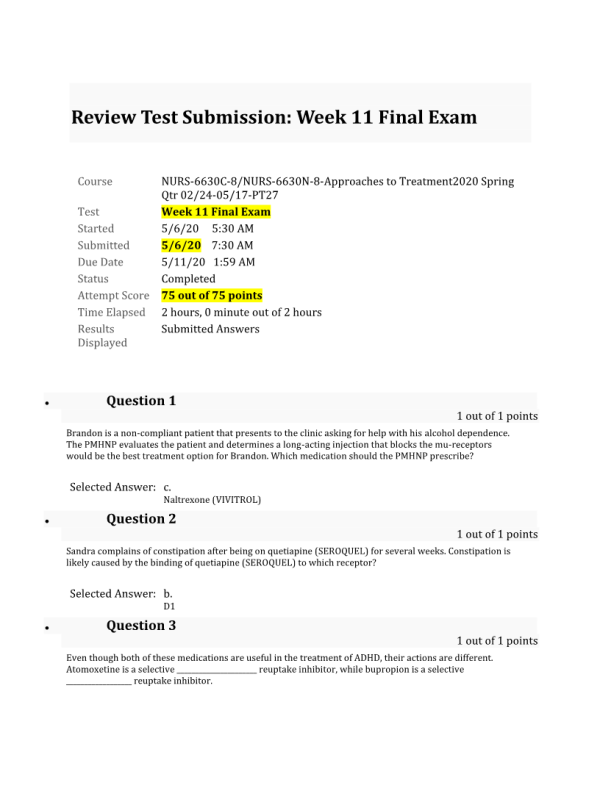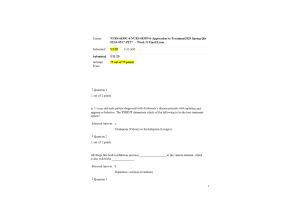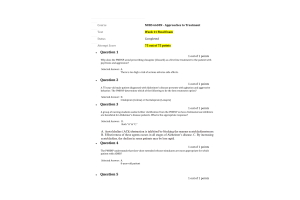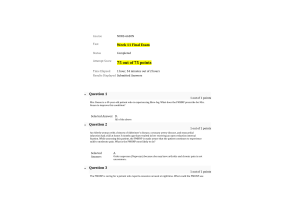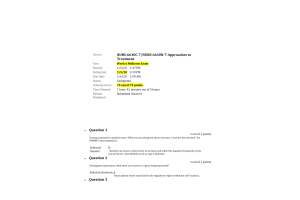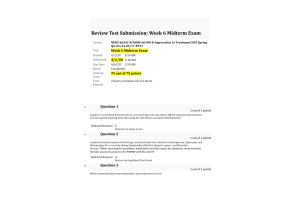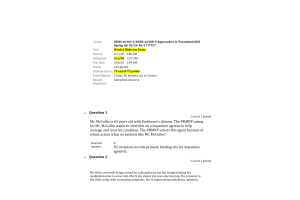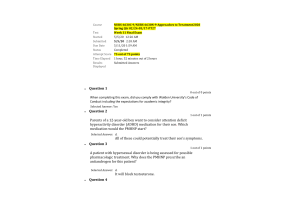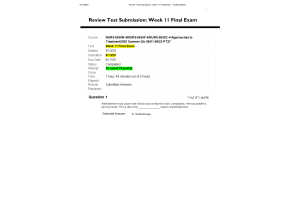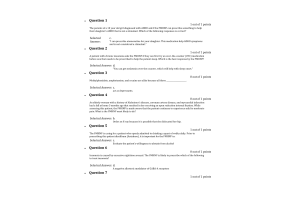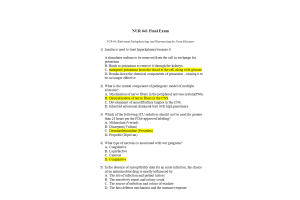NURS 6630C-8, NURS-6630N-8; Exam - Week 11 Final (75 out of 75 Points)
- $49.00
NURS 6630 - Psychopharmacologic Approaches to Treatment of Psychopathology
- Question: Brandon is a non-compliant patient that presents to the clinic asking for help with his alcohol dependence. The PMHNP evaluates the patient and determines a long-acting injection that blocks the mu-receptors would be the best treatment option for Brandon. Which medication should the PMHNP prescribe?
- Question: Sandra complains of constipation after being on quetiapine (SEROQUEL) for several weeks. Constipation is likely caused by the binding of quetiapine (SEROQUEL) to which receptor?
- Question: Even though both of these medications are useful in the treatment of ADHD, their actions are different. Atomoxetine is a selective ______________________ reuptake inhibitor, while bupropion is a selective __________________ reuptake inhibitor.
- Question: An adult patient presents with a history of alcohol addiction and attention deficit hyperactivity disorder (ADHD). Given these comorbidities, the PMHNP determines which of the following medications may be the best treatment option?
- Question: The PMHNP is attempting to treat a patient’s chronic insomnia and wishes to start with an initial prescription that has a half-life of approximately 1–2 hours. What is the most appropriate prescription for the PMHNP to make?
- Question: A patient with chronic insomnia and depression is taking trazodone (Oleptro) but complains of feeling drowsy during the day. What can the PMHNP do to reduce the drug’s daytime sedating effects?
- Question: A young patient is prescribed Vyvanse. During the follow-up appointment, which comment made by the patient makes the PMHNP think that the dosing is being done incorrectly?
- Question: Alcohol enhances inhibition at ____________ synapses and reduces excitation at ______________ synapses.
- Question: A patient’s daughter calls your office with concerns that her mother is having significant gastrointestinal side effects. You review the patient’s chart and realize she is having side effects from donepezil (ARICEPT). What is the mechanism of the gastrointestinal disturbances?
- Question: Which of the following anticonvulsants increases serotonergic neurotransmission and GABAergic transmission, while decreasing glutamatergic neurotransmission?
- Question: A 75-year-old male patient diagnosed with Alzheimer’s disease presents with agitation and aggressive behavior. The PMHNP determines which of the following to be the best treatment option?
- Question: An interneuron is a neuron that has its cell body, dendrites, and axon within the spinal cord. The neuron can be considered excitatory if it contains ____________ or inhibitory if it contains ____________.
- Question: Which patient will receive a lower dose of guanfacine?
- Question: Mike wants to quit smoking. He has tried nicotine replacement and varenicline without success. He has asked for another medication to help him kick his habit. The PMHNP decides to try a medication that increases dopamine by prescribing a medications that can increase both norepinephrine and dopamine. Which medication did the PMHNP prescribe?
- Question: A patient with irritable bowel syndrome reports chronic stomach pain. The PMHNP wants to prescribe the patient an agent that will cause irrelevant nociceptive inputs from the pain to be ignored and no longer perceived as painful. Which drug will the PMHNP prescribe?
- Question: The PMHNP prescribes gabapentin (Neurontin) for a patient’s chronic pain. How does the PMHNP anticipate the drug to work?
- Question: The PMHNP is assessing a patient she has been treating with the diagnosis of chronic pain. During the assessment, the patient states that he has recently been having trouble getting to sleep and staying asleep. Based on this information, what action is the PMHNP most likely to take?
- Question: A patient with hypersexual disorder is being assessed for possible pharmacologic treatment. Why does the PMHNP prescribe an antiandrogen for this patient?
- Question: The PMHNP is teaching a patient with a sleep disorder about taking diphenhydramine (Benadryl). The patient is concerned about the side effects of the drug. What can the PMHNP teach the patient about this treatment approach?
- Question: The nursing staff asks the PMHNP for additional education regarding the treatment of agitation in dementia patients. Which of the following is correct?
- Question: The PMHNP is caring for a patient with chronic insomnia who would benefit from taking hypnotics. The PMHNP wants to prescribe the patient a drug with an ultra-short half-life (1–3 hours). Which drug will the PMHNP prescribe?
- Question: Which of the following substances has the highest probability of becoming dependent after a single use?
- Question: Which of the following is considered as a disruptive/impulse control behavior?
- Question: A patient presents with psychotic aggression. Which treatment option is best for a patient presenting with psychotic aggression due to impaired top-down cortical control and excessive drive from striatal hyperactivity?
- Question: A nursing students asks the PMHNP the difference between impulsivity and compulsivity. Which of the following responses is correct?
- Question: The PMHNP has been asked to provide an in-service training to include attention to the use of antipsychotics to treat Alzheimer’s. What does the PMHNP convey to staff?
- Question: The PMHNP understands that varenicline (CHANTIX) is an effective way to assist patients with smoking cessation. Why is this medication effective for these patients?
- Question: Parents of a 12-year-old boy want to consider attention deficit hyperactivity disorder (ADHD) medication for their son. Which medication would the PMHNP start?
- Question: The PMHNP evaluates a patient presenting with symptoms of dementia. Before the PMHNP considers treatment options, the patient must be assessed for other possible causes of dementia. Which of the following answers addresses both possible other causes of dementia and a rational treatment option for Dementia?
- Question: The PMHNP understands that bupropion (Wellbutrin) is an effective way to assist patients with smoking cessation. Why is this medication effective for these patients?
- Question: Heather is admitted for opioid withdrawals and detoxification. The PMHNP decides to prescribe an alpha-2 adrenergic agonist to reduce the symptoms of autonomic hyperactivity during withdrawal and aid in the detoxification process. Which medication did the PMHNP prescribe?
- Question: Heather is admitted for opioid withdrawals and detoxification. The PMHNP decides to prescribe an alpha-2 adrenergic agonist to reduce the symptoms of autonomic hyperactivity during withdrawal and aid in the detoxification process. Which medication did the PMHNP prescribe?
- Question: Daniel is a 33 year old patient with ADHD and multiple comorbidities: mood disorder, alcohol abuse, ADHD, and nicotine dependence. Which comorbidity should be treated first?
- Question: The PMHNP wants to prescribe Mr. Barber a mood stabilizer that will target aggressive and impulsive symptoms by decreasing dopaminergic neurotransmission. Which mood stabilizer will the PMHNP select?
- Question: The PMHNP is performing a quality assurance peer review of the chart of another PMHNP. Upon review, the PMHNP reviews the chart of an older adult patient in long-term care facility who has chronic insomnia. The chart indicates that the patient has been receiving hypnotics on a nightly basis. What does the PMHNP find problematic about this documentation?
- Question: A PMHNP supervisor is discussing with a nursing student how stimulants and noradrenergic agents assist with ADHD symptoms. What is the appropriate response?
- Question: Molly is a 52-year-old female that has a diagnosis of fibromyalgia. She complains of fatigue and cognitive difficulties. Which medication is the PMHNP most likely to prescribe?
- Question: The PMHNP is evaluating a 7 year old pediatric patient for the treatment of ADHD. The PMHNP decides to prescribe a medication that is selective for alpha-2A receptors that has a lower incidence of sedation and hypotension. Which agent did the PMHNP prescribe?
- Question: The parents of a 7-year-old patient with ADHD are concerned about the effects of stimulants on their child. The parents prefer to start pharmacological treatment with a non-stimulant. Which medication will the PMHNP will most likely prescribe?
- Question: The PMHNP is attempting to treat a patient’s chronic pain by having the agent bind the open channel conformation of VSCCs to block those channels with a “use-dependent” form of inhibition. Which agent will the PMHNP most likely select?
- Question: A patient recovering from shingles presents with tenderness and sensitivity to the upper back. He states it is bothersome to put a shirt on most days. This patient has end stage renal disease (ESRD) and is scheduled to have hemodialysis tomorrow but states that he does not know how he can lie in a recliner for 3 hours feeling this uncomfortable. What will be the PMHNP’s priority?
- Question: A patient diagnosed with obsessive compulsive disorder has been taking a high-dose SSRI and is participating in therapy twice a week. He reports an inability to carry out responsibilities due to consistent interferences of his obsessions and compulsions. The PMHNP knows that the next step would be which of the following?
- Question: An 8-year-old patient presents with severe hyperactivity, described as “ants in his pants.” Based on self-report from the patient, his parents, and his teacher; attention deficit hyperactivity disorder (ADHD) is suspected. What medication is the PMNHP most likely to prescribe?
- Question: Which statement best describes a pharmacological approach to treating patients for impulsive aggression?
- Question: The PMHNP is caring for a patient with chronic insomnia who is worried about pharmacological treatment because the patient does not want to experience dependence. Which pharmacological treatment approach will the PMHNP likely select for this patient for a limited duration, while searching and correcting the underlying pathology associated with the insomnia?
- Question: Jordan is diagnosed with obsessive compulsive disorder. He has been trialed on several different SSRIs and is currently on high dose sertraline. He reports an inability to carry out responsibilities because of an obsession with handwashing. Which is the best treatment option for Jordan?
- Question: Jordan is diagnosed with obsessive compulsive disorder. He has been trialed on several different SSRIs and is currently on high dose sertraline. He reports an inability to carry out responsibilities because of an obsession with handwashing. Which is the best treatment option for Jordan?
- Question: The PMHNP is assessing a 49-year-old male with a history of depression, post-traumatic stress disorder (PTSD), alcoholism with malnutrition, diabetes mellitus type 2, and hypertension. His physical assessment is unremarkable with the exception of peripheral edema bilaterally to his lower extremities and a chief complaint of pain with numbness and tingling to each leg 5/10. The PMHNP starts this patient on a low dose of doxepin (Sinequan). What is the next action that must be taken by the PMHNP?
- Question: Antihistamines may cause side effects such as blurred vision, constipation, memory problems, and dry mouth. This is due to the _______________ effects of antihistamines.
- Question: Which medication is an irreversible inhibitor of aldehyde dehydrogenase that creates a negative and aversive response following ingestion of alcohol?
- Question: A patient on chronic opioids is currently on oxycodone ER (OxyContin). The PMHNP is consulted to treat underlying depression. Under which circumstance should the PMHNP order naloxone (NARCAN)?
- Question: A patient is being prescribed bupropion and is concerned about the side effects. What will the PMHNP tell the patient regarding bupropion?
- Question: The PMHNP is assessing a patient who presents with elevated levels of brain amyloid as noted by positron emission tomography (PET). What other factors will the PMHNP consider before prescribing medication for this patient, and what medication would the PMHNP want to avoid given these other factors?
- Question: The novel neurotransmitter adenosine is responsible for the sleep-wake cycle by increasing throughout the day and diminishing during night. Which of the follow is an antagonist of adenosine?
- Question: The PMHNP is meeting with the parents of an 8-year-old patient who is receiving an initial prescription for D-amphetamine. The PMHNP demonstrates appropriate prescribing practices when she prescribes the following dose:
- Question: The PMHNP understands that slow-dose extended release stimulants are most appropriate for which patient with ADHD?
- Question: A patient addicted to heroin is receiving treatment for detoxification. He begins to experience tachycardia, tremors, and diaphoresis. What medication will the PMHNP prescribe for this patient?
- Question: Mr. Peterson is meeting with the PMHNP to discuss healthier dietary habits. With a BMI of 33, Mr. Peterson is obese and needs to modify his food intake. “Sometimes I think I’m addicted to food the way some people are addicted to drugs,” he says. Which statement best describes the neurobiological parallels between food and drug addiction?
- Question: Which of these characteristics does NOT meet the criteria for probably Alzheimer's dementia?
- Question: Jacob is a 7-year-old pediatric patient who has significant oppositional symptoms associated with his ADHD diagnosis. What is the best treatment for this patient?
- Question: A patient with fibromyalgia and major depression needs to be treated for symptoms of pain. Which is the PMHNP most likely to prescribe for this patient?
- Question: Methylphenidate, amphetamine, and cocaine are alike because all three _____________________.
- Question: The PMHNP is treating a patient with depression and fibromyalgia. The PMHNP chooses to prescribe a treatment that may help treat the patient's fibromyalgia and depressive symptoms. Which medication is the PMHNP likely to choose?
- Question: Antipsychotics are doses at a level that blocks ________% of D2 receptors.
- Question: A patient calls the clinic to ask about an over-the-counter sleep aid. What is the best response?
- Question: The PMHNP prescribed a patient lamotrigine (Lamictal), 25 mg by mouth daily, for nerve pain 6 months ago. The patient suddenly presents to the office with the complaint that the medication is no longer working and complains of increased pain. What action will the PMHNP most likely take?
- Question: A patient is prescribed D-methylphenidate, 10-mg extended-release capsules. What should the PMHNP include when discussing the side effects with the patient?
- Question: You have been consulted to evaluate a patient who presents with symptoms of dementia. The patient is experiencing memory deficit, aphasia, apraxia, and agnosia. Which treatment option is best for this patient?
- Question: The PMHNP is working with the student to care for a patient with diabetic peripheral neuropathic pain. The student asks the PMHNP why SSRIs are not consistently useful in treating this particular patient’s pain. What is the best response by the PMHNP?
- Question: The PMHNP is consulted to evaluate a patient in a long-term care facility that is having difficulties participating in group therapy each morning after breakfast. What is the likely cause of excessive daytime sleepiness?
- Question: The PMHNP is teaching parents about their child’s new prescription for Ritalin. What will the PMHNP include in the teaching?
- Question: A 72-year-old male patient is in the early stages of Alzheimer’s disease. The PMHNP determines that improving memory is a key consideration in selecting a medication. Which of the following would be an appropriate choice?
- Question: A 9-year-old female patient presents with symptoms of both attention deficit hyperactivity disorder (ADHD) and oppositional defiant disorder. In evaluating her symptoms, the PMHNP determines that which of the following medications may be beneficial in augmenting stimulant medication?
- Question: Neal is complaining of restless leg syndrome and insomnia. Which first-line medication should the PMHNP prescribe to treat both?
- Question: A patient with chronic insomnia asks the PMHNP if they can first try an over-the-counter (OTC) medication before one that needs to be prescribed to help the patient sleep. Which is the best response by the PMHNP?
- Question: When completing this exam, did you comply with Walden University’s Code of Conduct including the expectations for academic integrity?
